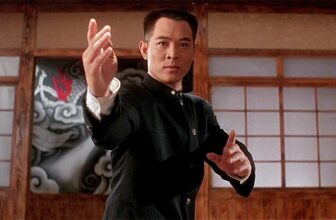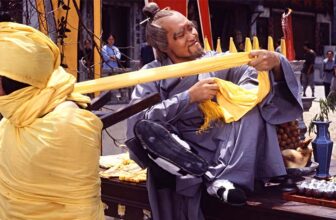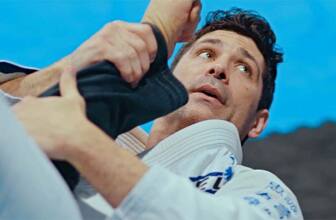
The ground-breaking film directed by Chang Hsin Yen, that transformed Chinese wushu champion Li Lianjie into movie superstar Jet Li, and led to the eventual re-opening of the real Shaolin Temple.
Trailer
Cast
The main cast was made up of mainland Chinese wushu champions, most of them making their film debuts.
At the time production started, Jet Li was a national sporting hero, having been the leading Chinese national wushu champion throughout the seventies. He was the perfect choice to play the part of the impetuous young hero “Chen Yuan”, and his natural martial arts ability meant he could perform his own stunts.
Real-life Praying Mantis master Yu Hai, plays “Shifu”, the master of the trainee Shaolin monks. Yu Hai was one of the founding fathers of modern wushu. He served as one of the cultural ambassadors during the historic 1974 wushu tour of the USA. Along with Jet Li, they demonstrated Chinese martial arts on the White House lawn for President Nixon.
Another martial arts champion Yu Chenghui also launched his acting career as the villain, the wicked “General Wang Jen Tse”. In real-life Yu Chenghui was an expert with the two-handed straight sword, and was a champion with his Zuijian, or “Drunken Sword”.
Highly skilled Chinese opera performer Ding Laam plays “Bai Wuxia”, who it emerges is the Shifu’s daughter.
Hu Jianqiang plays “Wu Kong”, a young leader of the Shaolin Monks. By the age of 14, Hu was the Zheijiang Wushu Team’s top athlete and had begun touring internationally with China’s national team. Hu won numerous national individual wushu titles in Southern Fist (Nanquan), Ground Tumbling Fist (Ditang quan), Shaolin Staff (Shaolin gun), and Monkey Staff (Hou gun). It was at the 1978 championships in Shandong Province that Hu was spotted by Hong Kong film director Chang Hsin Yen and cast in “The Shaolin Temple” film.
Another mainland wushu champion making his movie debut was Ji Chunhua as “Tu Ying”. His strong frame and bald head defined him in this film, and for most of his ensuing career, as the ideal henchman.
The real historical figure of “Li Shimin” is portrayed by Wang Guang Quan. Learning martial arts as a teenager, Wang specialised in northern Wushu for the Chinese National Team. In the late 1980’s, he began studying Tibetan Buddhism, and by the 1990’s, Wang had given up show business to teach Tibetan Buddhist yoga, changing his name to Rinchen Gongga.
Former Chinese National Wushu Team member Sun Jian-Kui plays the drunken monk “Shih Kung”.
Plot
Based loosely on Chinese history, the film is set during the transition period between the Sui Dynasty and the Tang Dynasty. A young man (Jet Li) is taking part in a ceremony to formally become a Shaolin monk. As the Abbot asks him to accept the commandment “thou shalt not kill”, he flashes back to the events of the past couple of years when he was named Hsiao Hu.
Hsiao Hu and his father, a renowned warrior known as Mighty Leg Chang, were enslaved by General Wang Jen Tse . His father is killed by General Wang after stepping in to defend a fellow prisoner. However, our young hero manages to escape and arrives at the Shaolin Temple. Barely alive, the Temple monks nurse him back to health. As Hsiao Hu recovers, he befriends the Shifu, the Shifu’s daughter Bai Wuxia, and several of the younger disciples, many of whom had lost family at the hands of the General. After seeing them practicing Shaolin kung fu, which is reserved only for monks, Hsiao Hu asks Shifu to train him to be a monk too.
Given the name Chen Yuan, our hero begins his training in the Shaolin martial arts but struggles to contain his lust for revenge against General Wang Jen Tse. When Chen Yuan loses control during training, nearly killing his sparring opponent, he is expelled from training. Meanwhile, whilst tending to her flock of sheep, Bai Wuxia is captured by Tu Ying and taken to the General.
After a protracted fight with the General and his guards, Chen Yuan rescues Bai Wuxia and they return to the Temple. Chen Yuan is re-accepted by Shifu and continues with his training. Whilst out one day, Chen Yuan encounters Li Shimin being pursued by the General and his men, and helps him to escape.
Realising the monks have been sheltering Li Shimin, General Wang gains authority from Emperor Chang to attack the Temple with his army and burn it to the ground.
In an epic final showdown, the Shaolin Monks must use all their skills to save themselves and their ancient temple.
Action
The martial arts action in “The Shaolin Temple” is nothing short of superb, and there is plenty of it. Casting authentic wushu champions, many of them in their prime, proved to be a masterstroke. There are no wires and very little use of trampettes or camera tricks and angles to exaggerate the techniques on display.
After a rather jolly intro song and a brief historical explanation to set the scene, we are straight into the film’s first fight. Even though his wrists and legs are manacled, Mighty Leg Chang moves with incredible agility to fight the bald-headed Tu Ying. When Chen Yuan sees the General join in to deliver a potentially fatal blow to Chen’s father, he leaps into action, and we are introduced to the fresh-faced Jet Li for the first time. Although fleeting, the audience is given a taste of the energy that Jet Li brings to the proceedings, with his northern-style wushu kicks, leaps and kip ups.
The action entertainment in this film doesn’t just come from the fight scenes. Cut to our first glimpse of the monks training at the famous Shaolin Temple. Ten monks are practicing Gunshu (cudgel) with near-perfect timing in their twirls and strikes. There are several training scenes showing the monks running up steps with buckets of water on their shoulders, or working in the vegetable patch and practicing frog leaps. Using authentic locations, the actors stomp their feet on the same dimpled, stone floor that the real monks allegedly wore down with many years of training. Chen Yuan witnesses the monks performing a variety of skills, which inspires him to want to learn martial arts too. The scene is a real showcase for the talents of each performer, with demonstrations of Daoshu (broadsword), Qiangshu (spear), Jiu jie bian (whip chain), Shengbiao (rope dart), San jie gun (3 section staff), Ditanquan (ground tumbling boxing) and Tang Lang (Praying Mantis). As a result of this film, these demonstrations became synonymous with Shaolin kung fu, and modern Shaolin performances often emulate the exact same exhibitions of contemporary wushu.
Later that night, at a clandestine meeting in the woods, the monks sample some illicit meat, and for one monk, Shih Kung, a sneaky drink of wine! Cue a performance of Zui quan, or drunken boxing, which leads into drunken pole, by real-life champion of the form, Sun Jian-Kui.
As Chen Yuan’s training progresses, he must spar with one of his seniors. Jet Li and Hu Jianqiang display great form, speed and energy in a sparring match that includes northern leg and longfist techniques, grappling and pressure points.
Chinese opera performer Ding Laam has a great fight scene with Ji Chunhua, revealing her flexibility, grace and timing. When Jet Li later comes to her rescue, he faces multiple guards, Ji Chunhua, and eventually Yu Chenghui. The fight progresses into a battle of the drunken styles, with Jet Li adopting the drunken pole from earlier in the film, and Yu Chenghui, the drunken sword. The choreography is much more in the style of the flow and grace of the wushu form, rather than the full-on blows of Jackie Chan’s “Drunken Master” films. When Jet Li loses his weapon, he uses ground tumbling boxing to avoid his foe’s deadly blade.
Chen Yuan returns to training at the Temple, and Jet Li gets his moment to show the range and versatility of his martial arts skills. The beautifully filmed “Four Seasons” scene allows Jet Li to demonstrate some of the forms that made him an all-round national wushu champion. We see Chanquan (longfist) in the summer, San jie gun (3 section staff) in the autumn, Qiangshu (spear) in the winter (using the snow to great effect), and Daoshu (broadsword) in the spring. The whole sequence is a joy to behold, with some great use of slow-motion photography to emphasise Jet’s precision.
The last third of the movie is virtually all action. Chen Yuan, Bai Wuxia and Li Shimin run into the General’s soldiers in the marshes. Chen Yuan takes on multiple opponents using his Jianshu (straight sword) skills, whilst Bai Wuxia and Li Shimin make their escape on a raft. In the nick of time, Chen Yuan’s fellow monks arrive on horseback. As in the earlier demonstration scene, each monk uses an individual skill or weapon to fight the enemy soldiers.
The epic finale takes place within the Temple walls itself. General Wang Jen Tse’s soldiers storm the grounds, forcing the monks to defend themselves with a combination of weapon skills and open hand techniques, whilst utilising an environment of trees and stone walls to fight on, around, and leap off of.
The final showdown between Jet Li and Ji Chunhua takes place at the river’s edge, with all manner of weapons and techniques being employed, including rope dart, spear versus spear, and double broadsword versus straight sword.
Summary
“The Shaolin Temple” deserves an important place in history. Not just in martial arts movie history, but culturally and politically in the history of Communist China, with the modern rebirth of the Shaolin Temple and mainland Chinese cinema.
The film was made and released at the height of the Cold War, when most films had been either heavily censored, or just government propaganda. The Communist government also had a tricky history with the real Shaolin Temple, having denounced and imprisoned the last remaining monks and banning all Buddhist material in the 1960’s.
For the first time in a long time, Chinese cinema audiences had a genuinely entertaining and inspiring film to go and see. With such a large population, the movie sold literally millions of tickets at the box office, and was an instant hit, not just in the mainland, but all over Asia. The movie’s popularity led to private martial arts schools springing up all around the ruins of the Shaolin monastery. Martial arts teachers rushed to take advantage of the temple’s renewed fame, building martial arts schools all around Shaolin, even on the temple grounds. Restaurants and tourist shops soon followed to serve the thousands of kung fu students and tourists who began to pour into the area. By the late nineties it was estimated that more than a million tourists visited Shaolin every year. Recognising the financial benefits and positive public image generated by the Shaolin Temple, especially internationally, the Chinese government encouraged wushu performers to train in the area and invested heavily in the re-development of the temple. A state-sponsored Shaolin Monk wushu performance troupe was established, which still successfully tours the world, putting on shows in theatres and giving public demonstrations.
In 1999, the government appointed Abbot Yongxin, the first Shaolin Abbot since 1664, when Abbot Yongyu was forced to leave the temple without naming a successor. One of Abbot Yongxin’s first official actions was to clear the temple grounds of all the martial arts schools and souvenir stands that had sprung up in the previous 15 years or so, and expel kung fu teachers dressed as fake monks. Today there are numerous “Shaolin Temple Schools” established outside of China.
Aside from this cultural phenomenon, it is the film that launched Jet Li’s career. His fresh-faced energy was perfect for the role, and his authentic wushu skills were captured on film at possibly the peak of his abilities. Yu Hai delivers a great performance, giving weight and dignity to the role of “Shifu”. Using real-life team mates as the monks also brings an authenticity to their camaraderie. The action is well-choreographed, and it is great to see the genuine fighting applications of many of the wushu techniques, which are not always obvious when they are observed as a performance or tournament art.
Although there are lots of the Shaw Brothers-style camera zooms, the action is well shot and edited, and there are some beautiful vistas of the authentic locations.
“The Shaolin Temple” is a bona-fide classic that all martial arts fans should seek out and enjoy!
Trivia
- Production of “The Shaolin Temple” began in 1979 with Chinese opera performers from Henan Province. After three months the film’s investors decided they didn’t like the results. They decided to recast and start again. The director, Chang Hsin Yen thought that it was probably easier to teach wushu champions to act than it was to teach stage actors to perform authentic wushu. Only four opera actors remained in the film, one of which was Ding Laam.
- Filming of “The Shaolin Temple” took two years to complete and it was eventually released in 1982.
- One of the reasons the film took so long to complete was due to several injuries to the cast members. Yu Hai and Yu Chenghui both broke their arms learning to ride horses.
- Hu Jianqiang sustained a serious leg injury while filming a scene with Jet Li. According to Hu, Li was supposed to do a double kick in the air striking him and another actor in the face before landing. Because the ground was soft, Hu’s leg got caught under Li when he came down. “I still have problems with my leg,” says Hu. As a result, Hu needed to wear a leg brace for the final fight scene of the film.
- Although the film broke box office records, the cast, including the star Jet Li, were paid a pittance of a wage by the state!
- Chang Hsin Yen had directed several entries in the Wong Fei-hung film series starring Kwan Tak-hing. In 2014, Chang was presented with a Lifetime Achievement Award at the Hong Kong Film Awards.






